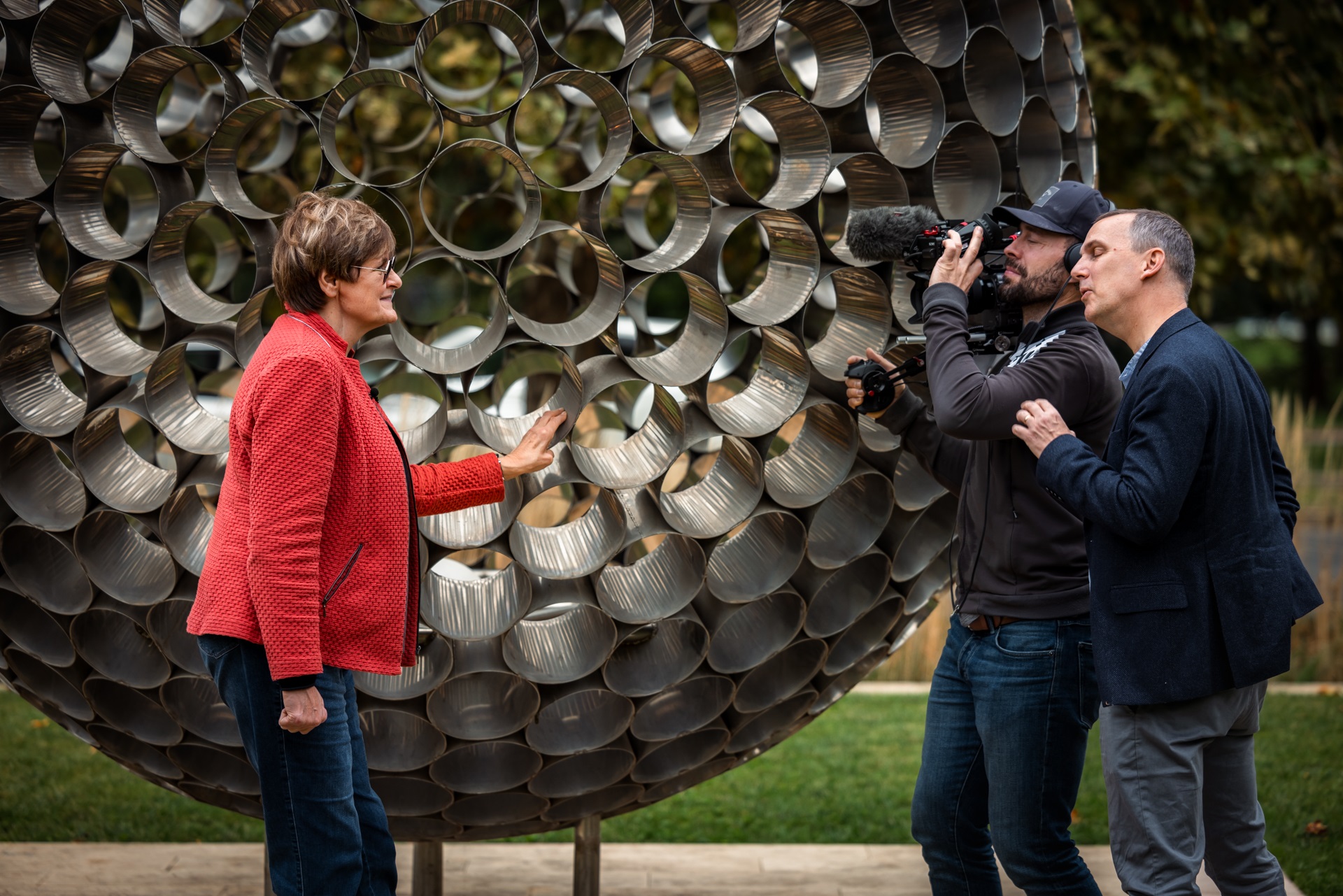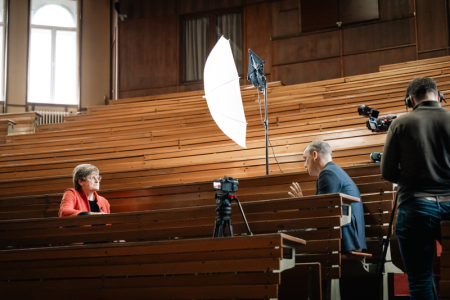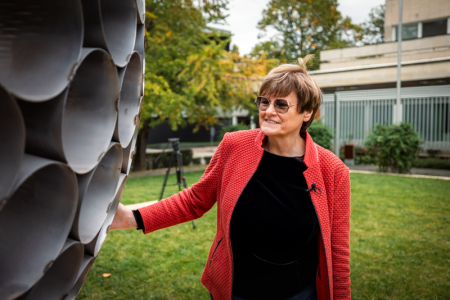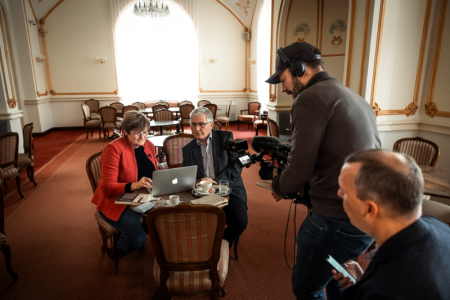
Animations and archival footage add color to this year's television portrait of Nobel laureates. The 59-minute film illustrates some of the uplifting, dramatic, and sporty moments of the researchers' lives. In the first twenty minutes of the summary, Katalin Karikó walks and talks at significant places in her life, including locations at the University of Szeged. From the 54th minute, Ferenc Krausz jogs and explains. The stories of two Hungarian researchers frame the film celebrating this year's Nobel laureates, scheduled for broadcast on STV2.
Report from our correspondents sent to the Nobel Week in Stockholm – Ilona Újszászi and István Sahin-Tóth
The SVT2 team in Sweden aimed to create the best possible documentary on the 2023 Nobel laureates. The film, titled "Nobel: New Vaccines, Colorful Dots, and the World of Electrons," takes on the presentation of three scientific fields and research topics. 8 Nobel laureates share the 59 minutes of the bellow report.https://www.svtplay.se/video/8Wv6pkZ/nobel-nya-vaccin-fargprickar-och-elektronernas-varld
The review begins with the reminissence of Katalin Karikó and Drew Weissman in English and the dark and tragic moments of the Covid-19 pandemic. We then witness the legendary TV footage: researchers Katalin Karikó and Drew Weissman, laying the foundation for the development of mRNA-based vaccines, receive the result of their work—the Covid vaccine.
The film presents the young Katalin Karikó's Hungary in a thriller-like manner, from which she departed: the secret police, currency sewn into a teddy bear. After a replay of the period spent with the American research colleague, Katalin Karikó and Béla Francia's daughter, two-time Olympic champion Zsuzsanna Francia, also speaks.

Katalin Karikó wrote her entrance exam in the auditorium of the University of Szeged.
’We meet the physiological and medical Nobel laureates Katalin Karikó and Drew Weissman. They stand behind the development and technology of Covid-19 vaccines. For a while, almost no one understood the possibilities in their mRNA technology – their publication went unnoticed. But in the end, their method proved to be the fastest way to effective vaccines,’ - continues the STV2 film. Interesting and vivid animations explain key concepts.

The TV crew accompanied Katalin Karikó to her first workplace, the Szeged Biological Research Centre.
The team led by editor and reporter Johan Bergedorf mobilized and utilized articles and interviews, photos, and videos available from the University of Szeged, MTVA, Geofilm, and the University of Pennsylvania. Previously recorded and archival film excerpts from Hungary were supplemented with fresh footage by cinematographer Daniel Hols at Katalin Karikó's alma mater in Szeged on October 15, 2023.
 Half a century ago, the Virág Confectionery was still a popular meeting place. Nobel Prize winner Katalin Karikó and her former university classmate Imre Boros, professor at the SZTE, browsing old photos.
Half a century ago, the Virág Confectionery was still a popular meeting place. Nobel Prize winner Katalin Karikó and her former university classmate Imre Boros, professor at the SZTE, browsing old photos.
When the thermometer in Stockholm shows -17 degrees Celsius, in the pleasantly warm hotel room, we eagerly switched between TV channels. We observed that among the Swedish television channels, SVT2 also considers the presentation of research topics recognized with the Nobel Prize important.
In the middle of their 59-minute film, Moungi Bawendi, Alakszej Ivanovics Jekimov, and Louis E. Brus also appear. The three researchers received the Nobel Prize this year for the discovery and foundation of quantum dots. Here, we don't get the tiny details of life stories as in the case of the Karikó-Francia couple. However, we find out why the sounds of pipe organs can be represented by colourful wave lines.
After Ferenc Krausz, Anne L'Huillier, and Pierre Agostini appear in the frames: the third part of the film uses animations to illustrate the essence of attoseconds.
The frames and animations of the film, available in Swedish since December 4, 2023, on the SVT2 channel, are self-explanatories. They help understand the essence of the Nobel Prize-recognized achievements in life sciences, Chemistry, and Physics.
https://www.svtplay.se/video/j16goY5/nobel-portratten/medicinprisportrattet?info=visa
The trailer for the short film featuring the Karikó – Weissman research duo emphasizes: 'For a while, almost no one understood the possibilities in their mRNA technology – silence greeted their researchers. But in the end, their method proved to be the fastest way to effective vaccines. We also hear about Katalin Karikó's escape from Hungary, beyond the country's secret police, with currency smuggled into a teddy bear.'
The short film picturing the three researchers sharing the Nobel Prize in Chemistry, highlights Moungi Bawendi, a researcher who copes with his inner uncertainties through rigorous physical training. The discovery of quantum dots adds colour to the screens of computers and mobiles. We meet his colleagues, Aleksej Yekimov and Louis Brus.
From the team of Physics Nobel laureates, the film prominently features the French-Swedish Anne L'Huillier, who 'gave us tools to peek into the extremely small and fast world of electrons – inside atoms and molecules. The discovery could pave the way for faster and smaller electronics alike.' The film also treats Pierre Agostini and Ferenc Krausz as co-stars.
The fifth short film presents the Nobel Laureate Claudia Goldin and her work at Harvard University while walking the dog. The economist sought answers to why men earn more than women and whether it's possible to invest in family life without financial loss.
You can also meet 'this year's Literary Laureate Jon Fosse in his literary environment in Vestlandet, Norway. The creator takes us to his birthplace, Fosse, by the fjord, where his poetic world is filled with rain and darkness, angels and light, and where words float among the mountains...'
Nobel Peace Prize winner Narges Mohammadi speaks about her everyday life in prison and yearning for her children, paying a daily price for her struggles...
*
A distinctive feature of the Swedish educational method is that an article is also created from the film:
Katalin Karikó shared that a team at the University of Szeged is working on a vaccine against candida infection (a fungal disease). It is heart-warming to read in winter Stockholm that the future is taking shape at the University of Szeged.
Find more articles on our 2023 Nobel Weeks page.
Ilona Újszászi
Photos by István Sahin-Tóth
Translated by E.SZ./NKI

